David K
Honored Nomad
        
Posts: 64493
Registered: 8-30-2002
Location: San Diego County
Member Is Offline
Mood: Have Baja Fever
|
|
EL MARMOL/ EL VOLCAN article on BajaBound.com
Here is my third trip article for Baja Bound's newsletter... enjoy!:
https://www.bajabound.com/bajaadventures/bajatravel/the_onyx...
[Edited on 3-6-2020 by David K]
|
|
|
David K
Honored Nomad
        
Posts: 64493
Registered: 8-30-2002
Location: San Diego County
Member Is Offline
Mood: Have Baja Fever
|
|
Additional photos that didn't make it onto the article...
The Vision of Peace (Indian God of Peace, 1936) onyx statue in St. Paul... the world's largest... from El Marmol onyx:
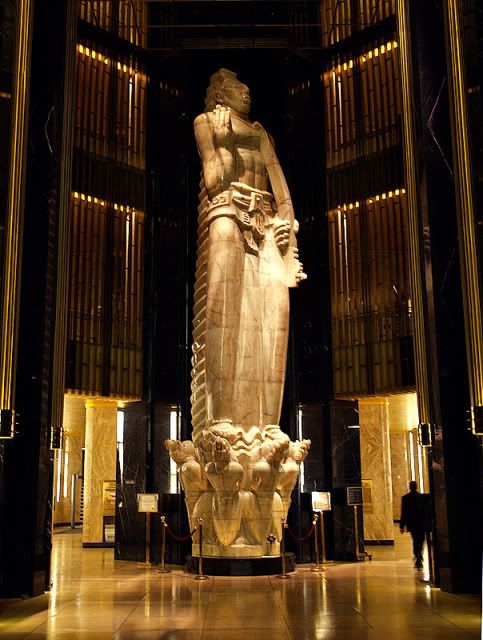
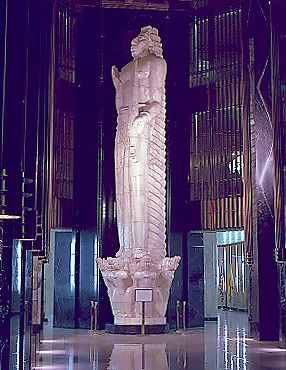
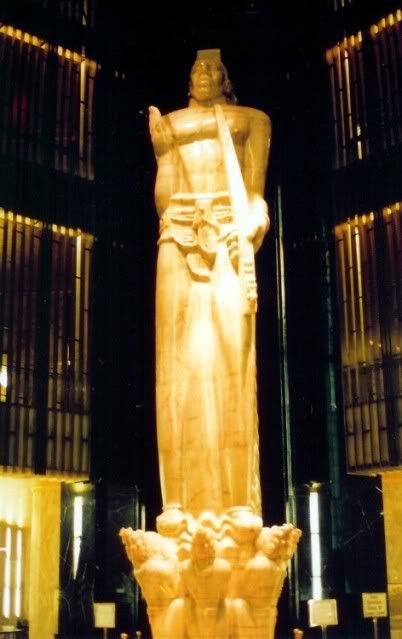
|
|
|
Bob H
Elite Nomad
     
Posts: 5867
Registered: 8-19-2003
Location: San Diego
Member Is Offline
|
|
Very interesting article David.
Here's a shot we took of the grave site in El Marmol...
Onyx everywhere...
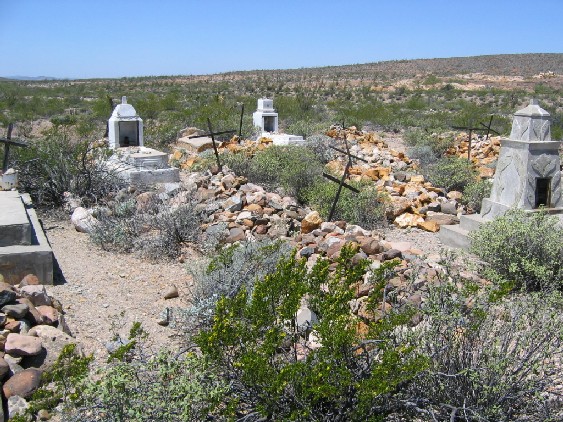
The SAME boiling water that softens the potato hardens the egg. It's about what you are made of NOT the circumstance.
|
|
|
David K
Honored Nomad
        
Posts: 64493
Registered: 8-30-2002
Location: San Diego County
Member Is Offline
Mood: Have Baja Fever
|
|
Thanks Bob!
|
|
|
Bob H
Elite Nomad
     
Posts: 5867
Registered: 8-19-2003
Location: San Diego
Member Is Offline
|
|
I have more photos... Let me find them. This area is very interesting and I enjoyed your article.
The SAME boiling water that softens the potato hardens the egg. It's about what you are made of NOT the circumstance.
|
|
|
Ken Cooke
Elite Nomad
     
Posts: 8921
Registered: 2-9-2004
Location: Riverside, CA
Member Is Offline
Mood: Black Trans Lives Matter
|
|
Great side-trip!
I'll look forward to checking out this site with everyone next Friday! Thanks for the article, David.
|
|
|
wilderone
Ultra Nomad
    
Posts: 3779
Registered: 2-9-2004
Member Is Offline
|
|
That statue is phenomenal. Did you know that the walls of the lobby of the Spreckles Theatre on Broadway in San Diego is also of El Marmol onyx.
Check it out some time.
|
|
|
David K
Honored Nomad
        
Posts: 64493
Registered: 8-30-2002
Location: San Diego County
Member Is Offline
Mood: Have Baja Fever
|
|
| Quote: | Originally posted by wilderone
That statue is phenomenal. Did you know that the walls of the lobby of the Spreckles Theatre on Broadway in San Diego is also of El Marmol onyx.
Check it out some time. |
YES!! I couldn't find photos... do you have any??
"The walls, ceiling and stairs of the grand lobby are finished in Predora onyx."
EL MARMOL onyx was shipped to San Diego for cutting/ polishing as that was the company's headquarters.
Before moving to El Marmol (El Tule/ Onyx) in 1919 to run the quarry, the Brown family lived on Cedros Island and ran the copper mine there.
Here is a 1913 photo on Cedros Island, that could include them?:
[Edited on 4-22-2011 by David K]
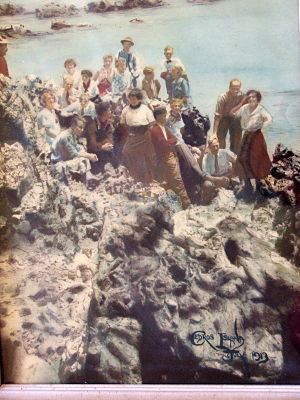
[Edited on 3-6-2020 by David K]
|
|
|
David K
Honored Nomad
        
Posts: 64493
Registered: 8-30-2002
Location: San Diego County
Member Is Offline
Mood: Have Baja Fever
|
|
Thanks to Neal Johns, from 2005 Nomad post:
MEMORIES OF EARLY DAYS IN BAJA CALIFORNIA
By Margaret Brown Baldwin
Images from the Article
During the last quarter of the nineteenth century, the northern portion of Baja California experienced its greatest economic boom since the
peninsula's discovery by Europeans in the 1530's. Two factors caused this rapid period of growth: the discovery of gold and other mineral deposits
plus colonization by foreign companies, which, under the sanction and regulation of the Mexican government, sought to develop vast quantities of
unoccupied public land. The sudden increase in population caused by miners and colonists stimulated not only the expansion of towns but agriculture
and stock raising as well. These ventures, although short-lived, can be credited with leaving an imprint on the region that is evident still today.
The following account by Margaret Brown Baldwin tells of her life as a young girl in Baja California during the latter half of this boom period. As
the daughter of a prominent mining engineer, George Playter Brown, her unique childhood encompassed the varied activities of her father's work. Born
in 1890 in the mining town of Leadville, Colorado, she moved with her family in 1895 to another gold and silver mining community, Mercury, Utah,
before coming to California in 1897. The family settled first in Bear Valley in the San Bernardino Mountains and then later relocated in Los Angeles.
It was here that George Brown first became interested in Baja California through one of the largest of the colonization and development firms, the
Lower California Development Company.
After returning to San Diego in the 1920's, Margaret Baldwin became an active resident and joined a number of civic organizations. These included the
Wednesday Club, Zlac, the Floral Association, and the San Diego Historical Society. Now at eighty-six she has slowed her schedule somewhat but still
retains an avid interest in the history of San Diego and Baja California. In May, 1975, she returned to the peninsula and visited many of the places
described in this article.
------------------------------------------------------------------------------
My experiences of Baja California were of long ago. My father, George Playter Brown, was a mining engineer. He was a strong man, full of spirit and
had a capacity to savor each day as a delightful experience. His tribe, as he called us children, were thrilled at leaving Los Angeles and going to
Lower California. Our father worked for the Lower California Development Company, formed in London, England. This corporation had leased millions of
acres of land from the Mexican government for the purpose of establishing mines and colonies. Colonists came from as far as Sweden, Denmark, Norway,
England and Russia. The Lower California Development Company also started a railroad and built the first real hotels at Ensenada and at San Quintin,
both of which were later destroyed by fire.
Our family arrived in San Diego on May 1, 1900 and stayed overnight at the Horton House. There was a fiesta going on and the plaza was gaily
decorated. There was music and dancing, the grass was green and the flowers were bright spots of color. The bandstand had a band that played most of
the evening. It was a gala occasion and we thought the town of San Diego was celebrating our arrival. Mother had a hard time getting us to bed that
night.
The following day, on May 2, we left for Lower California on an overnight steamer to Ensenada. This little town had been founded in 1877. In the late
1880's gold was discovered roughly sixty-five miles southeast of Ensenada at Alamo. By 1890, Ensenada was a thriving town and the capital of northern
Baja California. Besides mining, a flour mill, winery, tannery, and soap factory were the chief means of support. In addition, there were choice
places for fishing and hunting.
My father had charge of the mill and mines at Alamo. While he was getting our house built for us there, we stayed in Ensenada at the Iturbide Hotel
which had been built by the Lower California Development Company. The hotel stood high on a hill overlooking the beautiful bay. It was constructed of
wood and painted white with red trimmings like the Hotel del Coronado near San Diego. It had large verandas running almost entirely around the
building and was three stories high. There were many vines, geraniums and pepper trees growing in the gardens which were terraced clear down to the
wharf. There were cement steps going up and down to the beautiful beach, where we played most of the day.
We had an English governess who gave us far more than lessons in reading, writing, and arithmetic. We had shells, rocks, seaweed and the freedom of
the beach. We never lost sight of the transitory beauty that could not be carried home but could always be remembered. There was a swimming place a
mile away where we walked and had picnics. The other children at the hotel joined us. We ate at five o'clock as was the English custom and we always
dressed for dinner. This practice our mother followed in all the mining camps where we lived -- she said it kept us civilized. The hotel was a mecca
for English people and such lovely people they were! We were allowed to stay up and watch the dancing from the stairway when a ball was in progress.
We lived at the hotel for about six months until our house was ready at Alamo. To reach our new home we drove over a beautiful road, lined with many
oak trees while frequent springs bubbled forth. I still remember the wild stories told us by the stage driver. He pointed out the tree where a bandit
was hung. We stayed overnight at Ojos Negros, a big ranch owned at that time by Mr. Arnold Babc-ck and later by Mr. Robert Benton. We reached Alamo
the next day.
Our house was built around a court. There were large verandas on all sides to keep the house cool. In the courtyard were peach trees. When it rained
we could go out and pick up tiny gold nuggets where the rain had washed the earth away. However, we never became rich!
We still had our English governess but it was much more fun to go over to the Mexican school. We learned the multiplication tables in Spanish by
singing them. Our Spanish was good too. We could quarrel in Spanish and Mother never knew what we were saying. Our first Christmas here was made
wonderful by the men of the company. They built us a sleigh and a four roomed playhouse big enough to stand up in.
The region around Alamo is a desert on a plateau at an elevation between four and five thousand feet. At one place there is a dry lakebed. The
mountains are of volcanic origin and are mostly barren of vegetation except near the ridges. Cottonwood trees grew at camp as there was plenty of
water. We stayed nearly three years, until the mines were closed because of flooding.
In 1903 we began coming up to San Diego for school. In the summer, however, we visited Cedros Island, where our father had started copper mining. We
went by boat from San Diego to Ensenada, stopping at San Quintin where the Lower California Company had planted wheat fields, built a hotel, opened up
a salt mine and started a railroad to Ensenada. The hotel was a large one, elegantly furnished with red plush chairs and couches, and beautiful plants
and eucalyptus growing in the garden. Only a few of the trees are left. Harry Cannon, an Englishman, had been sent out as manager of the hotel.
There was a long wharf running out into the bay, a welcome sight to us children for we could get off the boat and run. We always stayed overnight at
the hotel, waiting for the tide to change so that we could get over a large sand bar at the mouth of the bay, and then we were on our way to Cedros.
It was on this first trip that we met Mrs. Robert Louis Stevenson, wife of the famous author, who had come down for a rest. She was a very nice little
gray-haired lady. She later came to Ensenada and bought a rancho just outside the town at El Sauzal.
Cedros is an island off the coast of Lower California, about five hundred miles south of San Diego and fifty miles off the coast of Lower California.
It is twenty-two miles long and twelve miles wide. We lived at the northern end of the island, while the copper mines were two and a half miles
inland. There was a smelter here and houses for the miners and their families. The country at the coast was barren and dry while at the mine there
were a few trees. On the very top of the island were lovely cedar trees and many wild flowers. I have never seen such larkspur, deep blue, red, yellow
and white. There were some pine trees also. Mesquite trees grew near where we lived and there was a good spring of water.
One Christmas at Cedros was held out-of-doors with a mesquite tree for our Christmas tree and a breakfast cooked over a campfire. We put up our
stockings thinking to fool Mother but she baked cookies late at night and put up letters cut from an oatmeal box saying, "Ho! Ho!" It was a wonderful
morning. Late in the afternoon the boat, overdue, came and our father was home with many gifts. It is still one of the outstanding Christmases of my
memory. The beautiful sunrise, the ocean and our tree were all we really needed, with Mother doing the cookies. It was real Christmas spirit.
In 1907 our father's mining activities took him and us to Punta Prieta -- located about three hundred and seventy miles south of San Diego on the
Lower California peninsula. The natives here were interesting in many ways. Their weddings, funerals, work and amusements were very different from
ours. When a marriage was celebrated the ceremony extended over an entire month. There was the "presentation" of the engagement and the sending of
this to the capital of the district. Since there were only three capitals hundreds of miles away from each other, it usually took a month for the
papers to go and come back signed by the governor. Everything is mañana (tomorrow and what is the hurry)! When the certificates finally arrived, the
marriage took place, and for a week there was dancing and feasting. Their funerals were also very different from ours. According to law at that time,
the body must be buried twenty-four hours after death and it could not be moved from the place where first interred until five years afterward. If the
deceased was an adult, services were held. If a child there were none. The only service at the cemetery would be a prayer or two.
It was amazing to see how these natives could use the things that nature had given them. The ocotillo for fences, the cardons which have a pithy
interior of balsa light wood furnished rafters for their roofs. The skill with which they made bricks from mud, houses from the bricks and cut palm
leaves to make a close, tight thatch which served as a roof was astonishing. The poorer houses were of brush. Those of the better classes were of
adobe with palm roofs and dirt floors.
The women and girls did all the hard work about the house. They toiled from early morn until late evening! They carried big buckets of water from the
well, quite a distance from their homes, on their heads, cut the wood for their fires and cooked for many men and children. But the men worked too. I
have seen men working day and night in the hottest weather, in the mines or on the surf boats, not even knowing how to swim.
Their wants were few and simple. They radiated a self-confidence and a calm contentment with life, as they lived in isolated independence. Their
complete self-reliance was wonderful. Given two hands, a bit of rawhide and a knife, they were thoroughly capable of taking care of themselves. They
were well-nourished and all their needs were met. Doves, brant, geese, quail, antelope, and deer were to be had for the taking. Other food such as
beans, meat, coffee and honey came from the camps where the men worked.
Such food was hard to get for it must all come by boat and then it had to be carried twenty-three miles by wagon or on small burros to the various
camps. Boats came down about once a month. At Santa Rosalia Beach we would wait anxiously for them. The wind would sob and moan and sweep with such
force that it seemed everything would be swept away before it. Inside a little white-washed house of stone, with a galvanized iron roof and windows
rattling, would be a big square table used for our food. In another corner crackled and burned an open fire, while smoke curled upward as if guided by
some unseen hand through a crack in the roof. A huge black iron pot holding Spanish beans sat on some rods at one side of the fire and a good-sized
coffee pot steamed and filled the room with a delicious aroma. Suddenly we would listen, and borne in on the roar of the sea and dying wind would come
a long, distant whistle. We threw open the big doors and way out in the blackness rocked the red and green lights of a ship's masts and we knew we had
food for another month! Many a time we would have a gold brick worth five hundred dollars and nothing but beans to eat. I think the words of the
Lord's prayer, "Give us this day our daily bread," has always meant a great deal to me because of this experience.
One Christmas, when the boat arrived, came a beautiful box from the San Diego mercantile firm of Klauber and Wangenheim. It contained nuts, raisins,
candy, cookies, fruit cake, canned pumpkin and mince meat, olives, apples, oranges and popcorn, all the things children love to eat. You see, this
kind of food was almost unobtainable because of the heavy duty. Mr. Wangenheim had arranged for it as a gift to us through the captain of the boat. A
"really, truly" Christmas gift, we always thought of Mr. Wangenheim as a real helper of Santa Claus.
There were many kinds of interesting trees and cacti near Punta Prieta. The elephant tree was a strange-looking specimen, having a bark that was
reddish, yellow and pink. It had a smooth, multiple trunk, and bore feathery pink blossoms in August. Mesquite bushes or trees grew in profusion,
lovely green feathery leaves with thorns on the tree branches. Always you found them near water. The cardon, a cactus, was a great towering growth
which had weird shapes so peculiar to the desert. They had beautiful pink blossoms and the fruit was good to eat. There was the ocotillo or
candlewood, its blossoms a vivid spectacle against the deep blue sky and the pastel shades of the desert mountains. At camp, it was used for fences.
If the sticks were put in right-side-up and it rained, they would grow and tiny green leaves would appear. The cirio tree grows only in this part of
the country. It looks like a cross between a birch or a cactus. Standing tall and straight, it has bark like a birch tree and from the bark grows a
profusion of little leaves while at the top are blossoms of a waxy white. These trees reach a height of around fifty feet and are two or three feet in
diameter at the base, tapering off at the top. Pitahaya cactus has a lovely red pulpy fruit, sweet and tangy. In one form or another it was an article
of food, making a wonderful drink or jelly. The chollas were used for wood. The mescal plant, which has yellow blossoms, the bees loved for honey.
Visignaga or barrel cactus, gave water on a camping trip. Datiles like our Joshua trees gave shade. The leaves of palms were used for house roofs.
Stories of missions rich in legends are common to Baja California. To tell them all would take too long. I shall speak of one which we saw. San Borja
was the name of this mission. According to tradition, a devout Spanish lady left the sum of sixty-two thousand pesos for the establishment of three
missions: "one in each of the three most inaccessible retreats in the world." All three places were found on the Lower California peninsula. Certainly
even today there are few more inaccessible spots than the sites of San Borja, Calamyet and Santa María.
San Borja was founded in 1762, over two hundred years ago, in a broad arroyo surrounded by high and forbidding mountains hundreds of miles from any
city or town. We reached the mission by riding on mules for a day and part of a night -- forty-five miles from my father's camp at Punta Prieta. This
was almost four hundred miles south of San Diego and twenty-three miles inland from the western coast of the peninsula. There were only two places
where we could get water and the trail was steep and narrow. Although very sure-footed as a rule, the mules would stumble at times because of the
rocky trail. We rested about two hours during the hottest part of the day and at ten o'clock at night we rested again until three in the morning. We
travelled a little over thirty miles during this time. Wanting to make San Borja before noon the second day, we saddled the mules and started. Riding
along by moonlight past giant cardons, bushes and through rocky gorges gave one a scary feeling. It reminded me of the scene in Rip Van Winkle where
poor Rip is climbing up the mountain and finds the little grey men playing at ninepins. I almost expected to see the men myself when I reached the top
of the last steep hill, but instead saw the sun stealing from behind the distant mountains and soon everything was flooded with sunshine and we were
near our destination.
Arriving at the mission, we were welcomed by the few natives who lived there. They took our mules and fed them and gave us the best of everything they
had. There was plenty of water at the mission, thus making possible the growing of olives, figs, pomegranates, watermelons, vegetables and alfalfa.
You may be sure we feasted royally.
All that was left of the mission was the stone church, a few rooms and a number of adobe ruins connected with them. One could see places in the nearby
mountains where Indians had taken out blocks of rock for building the church. The rafters were made of palm trunks. These were carried on the backs of
Indians, who had brought them from a place some eighty miles away. We had been to this place the year before and had seen the lovely trees. They were
over a hundred feet tall and you could look up and not see the sky, they were so thick.
The church was a long narrow room made of stone and plaster with an upper gallery and a winding staircase leading to a little tower where two ancient
bells hung. These bells were brought from Spain over a century ago and had looked down upon thousands of Indians and many priests in the days of long
ago. Now they saw only barren walls and the desolate huts of a few remaining Indians and their gardens.
On the walls of the church were old oil paintings, now torn but once very beautiful to the worshipping Indians and padres. All over the floor and in a
few places on the altar were large holes where the less devout had explored for hidden gold and money said to have been placed there in prosperous
days.
Adjoining the church were two small rooms, one on each side, which were used by the priests for confessionals. One looked like a torture chamber for
in the center was a large stone bowl and iron chain blackened by smoke and age, and in the bowl a skull yellow with age! Connected with the church
were a number of rooms, blackened and marked with the initials of passersby. The rooms were now used by the Indian families who had nothing but a few
blankets, a few tin dishes and a dress apiece. The old adobe ruins close to the church were used for the cattle.
Running the width of the interior of the church was a large altar on which stood the Patron Saint, Saint Francis, carved out of wood and painted in
many colors. The face was very natural and the whole figure was wonderfully well done. The sorrow of the years could be seen in his face and the eyes
almost seemed real they were so bright and yet so gentle. No wonder the Indians believed that there really was such a saint living over the seas,
thinking of them and loving them.
On the tenth of October the statue of Saint Francis would be decked out in most gorgeous robes and paper flowers for the yearly celebration of this
saint's day. This was why we had come. Praying and feasting followed one after the other. Candles of beeswax which had been made by the Mexicans at
their little ranches and carefully brought to the church were burning before the saint. Day and night services were held and the rest of the time was
spent in feasting and dancing until the wee small hours of the morning. This feasting generally continued for a week since the natives came from miles
around and as long as the food lasted they stayed.
From Mission San Borja we went on to Calmalli, another days' journey. Calmalli was at one time a large town. We stayed at the home of Mr. Ybarro and
his wife, a very wealthy man who was a good friend of my father. He owned many cattle and ranches and had gold mines at Camp Aleman and at El Arco.
Mr. Ybarro had a fine home and many servants. We had a twelve-course dinner with a new and lovely plate for each course. This was a thrilling
experience, coming from such simple living as we had at Punta Prieta.
The years at Punta Prieta were full of interesting experiences. We would go up to San Diego for school and then return to spend the summers at camp.
We had two house parties there with our friends from San Diego. The mines were eight miles away. There was a mill at the camp and an assay office. We
learned all about gold mining and had many adventures with our father.
In 1910 the Mexican Revolution started. The rebels came through our camp and took all the seventy mules our father had and most of the stock in the
store, leaving a promissory note that they would pay when they came into power, which of course they never did. In 1914 the United States government
sent word by a navy ship that we had to leave Lower California. The revolution was in full swing and it was not safe for us to stay. In 1920 we
returned to Baja California going to the onyx mines at El Marmol.
The El Marmol quarry is over 5000 acres in extent. The coloring in Pedrara Onyx, which was the name the onyx firm there went by, ranges from white
through tints of green, rose, yellow and brown. It is this variety of wonderful and beautiful marks that is its chief charm.
There were two ways of reaching the quarry, neither one a journey to be undertaken lightly. The overland route was the most difficult. The long
rainless months kept the road covered with fine powdery dust, torturing eyes, nose and throat. Sometimes a rain would come up and it would take over a
week to reach camp because of the many washouts and sudden streams. Only a few houses and an occasional Mexican hut would dot the long stretch of
magnificent country between Ensenada and camp. The road wound over mountains and around them, dropped into valleys and ran along the shore. Dozens of
different kinds of cacti grew on the mountain sides and in season yucca came forth with clusters of yellow creamy blossoms. There were rocky grades,
sharp turns, steep pitches and long stretches of sand.
Santo Tomas was one of the first stopping places after leaving Ensenada. It was in a fertile valley where the friars had planted vineyards over a
hundred and fifty-eight years ago. Some of the vines still bore fruit. There were olive trees, and the remains of the mission, and old wine barrels.
From Santo Tomas we started up the high grade that finally led down to San Vicente, twenty-five miles away. This part of the journey was long and
dangerous; the road had deep gullies and was scattered with sharp rocks that would puncture a tire or break an axle. Father used to say a little
prayer after we came over the grade. Today it is a paved road and wonderful to behold! The scenery on this part of the highway was very pretty. We
often stopped by a running stream to eat our lunch. We stayed overnight at the Johnson's ranch or San Antonio as it was called, or if we were early
enough we might reach Hattie Hamilton's ranch. Hamilton's was a cool welcoming oasis. It lay in the valley of Santo Domingo river and at times the
river was so full one could not get across with an auto and then the mules from the ranch pulled us over.
Miss Hattie was a wonderful hostess. She had come from England over seventy years ago as a young girl to be with her uncle. At the time we were there
they had a beautiful ranch. There were several acres of every kind of fruit-bearing tree that would grow in the locality, a vegetable garden, flowers,
many chickens and cows. Hattie's uncle, Mr. Young died in 1920 and was buried on the ranch which he left to her. There is a large onyx cross at his
grave that my father had made. It is another hundred and seventy-five miles to El Marmol from Hamilton's. The roads were bad with steep grades and
deep gullies. It was not an easy trip then nor is it even today.
The second way to reach the quarry was by steamer. It landed at Santa Catarina three hundred miles down the coast from San Diego and then followed a
fifty-five mile drive overland by auto. The road in itself was an engineering feat of no small consequence. The difficulties overcome in establishing
it were nearly equalled by those of maintaining it. This is all desert country with only two places to stop for water. Catarina village was the first
stopping place. Here we would rest at the home of Pasqual Cajames. A Yaqui Indian, Pasqual was married to an Indian princess. There was plenty of
water at Santa Catarina and many fruit trees and gardens.
The next stop was St. Augustine, twelve miles from the quarry. Here could be found good drinking and cooking water. The water at the onyx quarry
generally had such a high soda content that we used the water at St. Augustine -- hauling it back to camp in large wooden buckets.
The first view of the El Marmol onyx quarry was impressive. As you came over the summit of the surrounding hills a picture unrolled that was hard to
describe. The brilliant sunlight shining on exposed onyx transformed the great quarry into a field of glittering white. In the village, a tiny place,
the hundred or more employees were housed in buildings constructed by the company. When we were there we lived in a house built of onyx until the big
house was made ready for us.
The actual quarrying was the simplest part of the process in getting onyx from the quarries into a bonded yard at San Diego. The method used was
called the "wedge and feather." While much of the onyx lay exposed upon the surface a greater part was eight or ten feet underground buried beneath
masses of earth and rock, the accumulation of centuries. When this deposit had been removed holes would be drilled about every six inches and wedges
inserted in them. Upon driving in the wedge the block would split along the line of the drilled holes and could then be lifted by the derrick and
placed in position to be squared up.
Transporting the enormous blocks of onyx to the beach was a difficult and tedious haul. At first this was accomplished by means of mules. Sixteen
mules to a wagon could haul ten tons of onyx to the beach, returning with a cargo of food from the boat or perhaps coming back empty. A journey of one
hundred and ten miles, it took five days.
Because of the unfavorable coastline at Santa Catarina, vessels could not anchor close to shore so the onyx had to be conveyed out to them by means of
surf boats for a distance of some fifteen hundred feet. The huge blocks were taken from the pile at the beach and loaded onto hand cars and pushed out
to the end of the pier. Here the derrick came into use again by lifting blocks from the pier into ten ton lighter boats called pongos by the Mexicans
and built especially for this purpose. Pasqual Cajames was the best surf man my father had working for him. He was always in charge of the surf boats,
as he knew how to count the waves and how to pass through them.
Even in calm weather the surfing is a perilous task. Strong currents and high seas can stop the work for hours. In fair weather the average loading is
one-hundred and seventy-five tons in seven hours. A ship usually carried about six-hundred and fifty tons, so days would be spent at the beach. When
the onyx arrived in San Diego it was met by United States custom officials. Each block of onyx was unloaded, measured and consigned to the bonded yard
where it remained until sold. The bonded yard enabled the Pedrara Company to export to Canada, Australia and Europe as well as to the United States.
In the Spreckels Theater in San Diego, the entrance, lobby, walls and ceiling are entirely of Pedrara onyx. The soft glowing light shining through the
translucent onyx brings to mind childish dreams of a fairy palace -- forgetting all the hard work involved in quarrying and bringing the onyx here.
My travels in Baja California bring many things to mind. The long horseback rides over miles of untraveled country, the lovely wild flowers after a
rain, the strange cacti and trees to study, the rattlesnakes to make excitement, the gold, silver, copper, and onyx mines to learn about, the desert
winds, the wild surf and cool sea breezes to enjoy. One would look up at the golden moon and wonder about all that is good, getting nearer to God and
to nature and knowing there are many things which make one glad to be alive. The poet Rudyard Kipling perhaps said it best:
"Something hidden, go and find it.
Go and look behind the ranges
Something lost behind the ranges
Lost and waiting for you -- Go!"
|
|
|
BajaGeoff
Super Nomad
   
Posts: 1727
Registered: 1-11-2006
Location: San Diego and Campo Lopez
Member Is Offline
Mood: Heading To Baja!!!
|
|
| Quote: | Originally posted by wilderone
That statue is phenomenal. Did you know that the walls of the lobby of the Spreckles Theatre on Broadway in San Diego is also of El Marmol onyx.
Check it out some time. |
Oh that is too cool. I will get some photos of the Spreckels lobby to post....it is not far from our office!
|
|
|
David K
Honored Nomad
        
Posts: 64493
Registered: 8-30-2002
Location: San Diego County
Member Is Offline
Mood: Have Baja Fever
|
|
That would be great Geoff... yes, right up the street from Baja Bound World Headquarters! I wonder how far away the Southwest Onyx and Marble Company
was located... or was it called Pedrara Onyx? (per the article: "Pedrara Onyx, which was the name the onyx firm there went by")?
[Edited on 4-22-2011 by David K]
|
|
|
David K
Honored Nomad
        
Posts: 64493
Registered: 8-30-2002
Location: San Diego County
Member Is Offline
Mood: Have Baja Fever
|
|
LOOK ... MORE!
BIOGRAPHICAL OR HISTORICAL NOTE:
Established in San Diego under the direction of Leslie B. Mills and later operated by his son John Y. Mills, the Lyman-Mills Onyx and Marble Company
became the Southwest Onyx and Marble Company in 1921. It specialized in the fabrication of building fixtures and novelty works made of onyx from its
Pedrara Onyx Company quarry in Baja California, Mexico. After the quarry closed in the late 1970s and John Y. Mills retired in 1992, the Southwest
Onyx and Marble Company ceased operation.
SCOPE AND CONTENT NOTE:
This collection documents the Southwest Onyx and Marble Company in San Diego and its Pedrara Onyx Company quarry in Baja California. It contains
photographs by Herbert R. Fitch and others showing products made of finished onyx. Work samples include bank and office building fixtures in San Diego
and other cities on the West Coast; the lobby of Spreckels Theater; soda fountain counters in cafes and drugstores; and novelty works such as burial
urns, pedestals, lamps, and a punch bowl presented to the USS California by the citizens of San Diego. There are also snapshots of the desert, Mexican
families, dwellings, laborers, and an onyx quarry; workers and machinery in the company's San Diego factory; and Lee Passmore photographs of the
Pinole and its crew with blocks of onyx docked in San Diego harbor.
SUBJECTS INDEXED:
Pedrara Onyx Company (Baja California, Mexico)
Lyman-Mills Onyx and Marble Company (San Diego, Calif.)
Quarrying -- Mexico -- Baja California.
Industry -- California -- San Diego.
Stoneworking.
Laborers.
Mexicans.
Architectural elements.
Novelty works.
Samples.
|
|
|
fourninerpapa
Junior Nomad

Posts: 40
Registered: 11-2-2008
Member Is Offline
|
|
We chatted with Ralph last week at Rancho Santa Ines and he said they were mining the remaining onyx and crushing it for counter tops.
When we drove by the turnoff at El Marmol there were lots of trucks and equipment parked at the old RV park.
|
|
|
David K
Honored Nomad
        
Posts: 64493
Registered: 8-30-2002
Location: San Diego County
Member Is Offline
Mood: Have Baja Fever
|
|
Welcome to Baja Nomad!
Possibly you saw the equipment for the barite mine, past El Marmol "La Olvidada". We were there in 2011, not long after the road was graded all the
way out to a beautiful view of the islands. The mine was just getting ready for full production. Barite is highly prized for the oil drilling
industry.
I got word from motorcycle rider, and Dust to Glory producer Kevin Ward that they will be extending the road all the way to Hwy. 5 (near El
Huerfanito, perhaps) giving us finally a four wheeled vehicle shortcut between El Marmol/ Cataviña and San Felipe/ Gonzaga Bay! The guys on dirt bikes
have had the 'Bill Nichols' shortcut trail from south of Puertecitos to El Marmol for a few years now, but only bikes can use it!
Here is our trip report section on going to La Olvidada with photos: http://forums.bajanomad.com/viewthread.php?tid=52779
[Edited on 3-27-2013 by David K]
|
|
|
Graham
Senior Nomad
  
Posts: 558
Registered: 6-16-2006
Location: San Diego and DeTour, MI
Member Is Offline
|
|
I also stopped off to see Ralph and Pat and he told me the same thing about the processing of the onyx beds at El Marmol. Living and traveling in the
region he usually knows what's happening
I was surprised, but driving by Rancho Sonora at the turn to El Marmol there were many big trucks and an air of busyness that had me wondering if El
Marmol will soon be "gone."
Also, from there north I followed several of these heavy trucks on the highway! Definitely something big whatever is being "mined."
|
|
|
David K
Honored Nomad
        
Posts: 64493
Registered: 8-30-2002
Location: San Diego County
Member Is Offline
Mood: Have Baja Fever
|
|
We stopped and spoke with Rancho Sonora owner (son of the late Santiago?) at his San Simon windmill (with the worlds only onyx cattle trough)
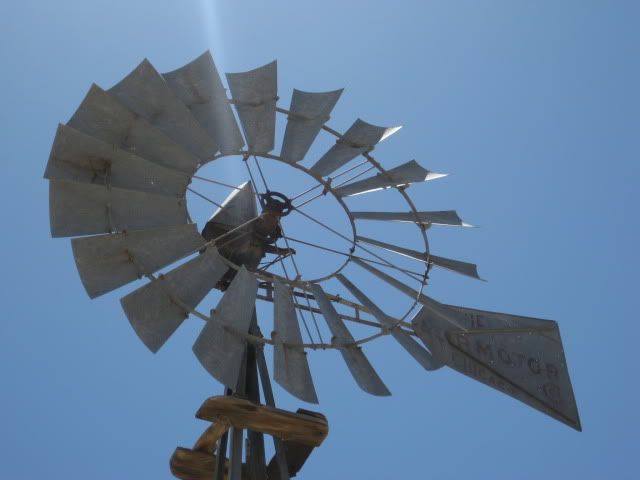

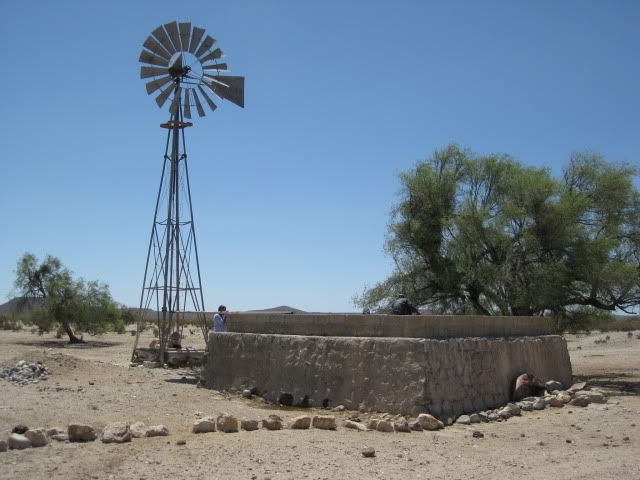
We followed them back to Rancho Sonora, and bought some onyx carvings for curios to talk home.
|
|
|
David K
Honored Nomad
        
Posts: 64493
Registered: 8-30-2002
Location: San Diego County
Member Is Offline
Mood: Have Baja Fever
|
|
Onyx mentioned on the history page for the theater:
http://spreckels.net/about-us/history/
[Edited on 3-6-2020 by David K]
|
|
|
David K
Honored Nomad
        
Posts: 64493
Registered: 8-30-2002
Location: San Diego County
Member Is Offline
Mood: Have Baja Fever
|
|
Updated the link to their history page.
|
|
|
|

